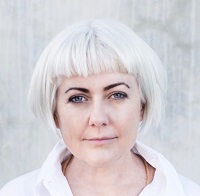Kym Barrett
Best dressed
Her name may not be familiar, but her work is unforgettable. Take Keanu Reeves' distinctive long coat and sinister eyewear in The Matrix series, Aquaman's figure-hugging metallic suit or the ethereal beauty of winged Clare Danes in Baz Luhrmann's groundbreaking Romeo + Juliet.
Acclaimed costume designer Kym Barrett has a list of credits to rival any big-name Hollywood actor, spanning film, television and theatre. Los Angeles has been her home for 28 years now, but the diminutive creative is holed up in Sydney during the coronavirus lockdown, waiting for filming to resume on the Marvel superhero movie Shang-Chi and the Legend of the Ten Rings, when asked to reflect on where it all began.
"I originally enrolled to study science at UNE - my father is a geologist - but many of my friends at Earle Page College were doing arts and working at the radio station and performing plays, and that took me into a Bachelor of Arts instead," Kym says. "It was amazing, and the UNE Theatre Department still holds a very special place in my heart. It was such a revolution for me, the freedom to try everything. I soon realised that acting was not my thing, and mostly designed and made sets for different shows."
Moving to Sydney after graduation, Kym successfully applied to study design at the National Institute of Dramatic Arts (NIDA), where she befriended fellow designer and film producer Catherine Martin and Catherine's partner Baz Luhrmann. Kym worked in theatre for eight years post-NIDA, most notably for the Sydney Theatre Company and Belvoir Street, before Baz invited her to become the wardrobe assistant on his debut feature film Strictly Ballroom. Four years later, he enlisted her again, as costume designer on his novel adaptation of Romeo + Juliet.
We were all young and learning our jobs; we were all on the cusp of something great, and the energy on the set was amazing
And the rest, as they say, is history.
Within three years, Kym was working on The Matrix, and her impressive show reel now includes each of The Matrix sequels, plus The Green Hornet, The Amazing Spider-Man, Cloud Atlas, Aquaman and Charlie's Angels. During projects large and small, in studios and makeshift sewing rooms in all parts of the world, Kym has perfected the craft of designing clothing that performers can "truly inhabit". "The biggest compliment someone can pay is when they don't speak about the characters as distinct from the actors," she says. "That's when I know the science of costume design has worked."
Psychology is also part of her demanding role. "I am quite a reserved person, but I have to become something of a psychologist on every job," she says. "Our department commonly gets actors straight off the plane, in all kinds of exhausted, inebriated and nervous states, but I have to immediately relate to them, often on an intimate level."
"If I have the time, we sit down and talk through how they see their character. I will often have an idea that I have discussed with the director, and some drawings. We discuss where the character might go, within the confines of the story. This helps me to get under the skin of the character and to better understand the anatomy of the film. Then I start getting ready for fittings and curate a couple of different ideas to build on."
There are practical considerations, of course, and function always comes before form. Hand-painted and engineered garments worn by performers in Cirque du Soleil's Totem, for instance, had to be both eye-catching and capable of withstanding athletic routines, and Keanu actually had three near-identical coats to disguise the harnesses required for his stunt scenes.
Architecture is important not just for the sets and scenery that we build, but for the balance, perspective and proportion of costume construction," Kym says. "There is a certain amount of physics and aerodynamics to costumes, too. I like to address the practicalities early, so that costumes can be worn in rehearsal, if possible. Often they become a touchstone for the character, a foundation upon which the actor can build the person.
Whatever the job, time period, cast or location, Kym does her own detailed research to put herself "in the mindset of the time". "If it's science fiction, you almost have to create a complete new reality before you start designing the costumes," she says. "My job is to serve as another storyteller, and to help the actors be faithful to the same story, so the audience can experience a moment in time when they live with those people."
While her job can be equal parts terrifying and rewarding - "every job has some overwhelming problem or disaster" - Kym enjoys having a "new family" to work with on each project. "For many of the movies I work on, we are almost like a prototyping house, especially in sci-fi; we have in our department or know someone talented and curious enough to invent what we need," she says. "Often we're working with very technical fabrics, even 3-D printing and using other new technologies to create fabrics just for that film. I have this underground network of people, a bank of Cinderellas with particular skills, who eventually get to have their time. I've even worked with aviation experts from Boeing."
In an industry renowned for its big budgets and even bigger egos, where awards are often considered the most valuable currency, Kym says having people in her team that she can count on and enjoy working with is priceless. "It's the human relationships that are most important in my job," she says.
It doesn't matter how much money a studio gives me, if they don't give me the people who are right to do the job and who work well with me, we won't be able to create something beautiful.

